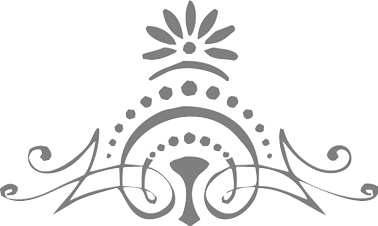

Face to Face
with Your Deck:
Practicing Tarot
We had the opportunity for nine of our tarot students to attend an evening party with us to give readings. Later on that night, all nine students took part in performing a tarot reading for one querent. It is rare that you get nine readers all performing the same reading for you at the same time.
This was a win/win situation for the querent and the students. The querent was really thrilled at having a reading done in this way because of the diverse input from the various readers. In turn, all the students felt confident that they had something unique to contribute to the reading as a whole, and they gained from having the support of their fellow students.
One thing we noticed is that, whilst each of the students had their own unique voice in the reading and one would think they would contradict each other, every insight actually added a new layer or perspective to the reading, supporting it and giving it depth.
The moral of this story is that the tarot is as deep as the people using it, and sharing your cards can be an incredibly rewarding and enriching experience.
Spreads for Fun and Practice
In this chapter, we will take the tarot skills we learnt in our first chapter and apply them in a range of great activities that are designed to get your tarot-brain engaged while creating new ways of thinking and seeing the world through the deck. These activities are based on an idea called “installation,” which works on the simple principle that in order to practice something, you have to unconsciously organise resources in your mind in a particular way. So we have designed these games and exercises to install and activate particular skills that are essential to tarot, based on decades of observing experienced tarot readers. These are methods we teach in our personal classes worldwide, revealed here for the first time. Your confidence will increase as you realise how quickly these skills can be learnt and practised while having fun!
Exercise: The Narrative Method of Storytelling
We will start by practising and installing the narrative method, a particular style of leading tarot author and teacher Rachel Pollack. You are going to create a story using the cards.
To start, split your tarot deck into three piles containing the court cards in one, the majors in another, and the minors in the third. Shuffle each pile and set it down. Select cards from each pile, without looking at them first, to create your story. Take the first card from the court card pile. This is the hero (or heroine). What sort of character is he (or she) and what sort of life does he lead? Feel free to refer to the companion book to your deck, if you have it, or our key concepts for that card given in chapter 1 of this book.
The next card, chosen from the majors, is the call to adventure. What changes in the hero’s life to start him on his journey? For example, if you draw the Tower, it would indicate a major and sudden disruption, while the Wheel of Fortune might mean a repeated wake-up call. Since no specific spread is associated with this method, lay the cards out in a line, face-up, or arrange them any way you like.
The next card, drawn from the minors, is the nature of the hero’s refusal to go on this journey or engage with this event or opportunity. What does he do? How does he respond?
The next card, a court card (or you can select a major card, if you prefer) shows the hero’s mentor. Who or what encourages him, teaches him, or provokes him to change, and how?
The next card, a minor, shows the first threshold that must be crossed to enter a different world. For instance, if it were the Nine of Cups, the threshold might be the hero feeling a little too pleased with himself.
Now choose three cards, each from any of the three piles, to indicate the tests, allies, and enemies the hero encounters in this new situation.
The next card, a major, shows the next threshold and the nature of the innermost cave—in other words, the secret heart of this story, a revelation, where the hero encounters the ordeal (select a minor or major card) and gains the reward (select a minor or major card). What is the ordeal? What is its reward?
The hero then takes the road back to the starting point (choose a minor card) and crosses a third threshold, experiencing a transformation or resurrection. The minor card tells us what this experience is all about and perhaps even how it happens in the story.
Finally, the hero returns home with a boon or a gift to bring to his previous situation. This is indicated by the final card, a major. What is it he learns or brings back from this journey?
This sequence is based on the archetypal hero’s journey described by Joseph Campbell and recast in contemporary style for authors, playwrights, and screenwriters in Christopher Vogler’s The Writer’s Journey. Underlying the hero’s journey is a universal story pattern, the monomyth. All our lives partake of this mythical structure that is revealed in our stories and creative acts. You may find that this spread reveals a lot about your own life story.
This method illustrates how we can utilise the cards in specific ways to creative dramatic narratives: the majors are archetypal forces at play, the minors the events in everyday life manifesting those forces, and the court cards the characters. Whilst practising creating stories in this manner, you are also unconsciously learning (“installing”) a new sense of how the cards represent these same elements in a spread for divination. You should find your ability to read cards progressively increasing and deepening as you practice this exercise.
Exercise: Doubt and Anti-Doubt
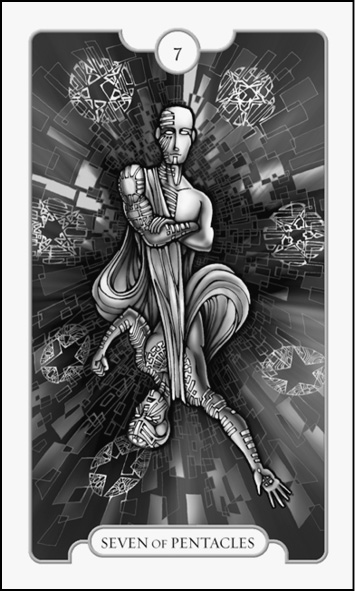

7 of Pentacles
(The Revelations Tarot)
Next, we will look at a simple way of facing up to your daily doubts in an exercise designed by Tali. This useful technique works with self-selecting tarot cards and then adds a little twist.6 It helps you accept, face, and resolve your doubts, particularly any self-defeating ones at the start of the day.
First, grab hold of your doubt. Hold it closely, really wallow in it; be certain that you have the doubt well and truly in your sight. This is the first trick and may seem counterintuitive, since most people try to push doubts to one side or take a “positive thinking” approach. We prefer always to start from a real position, embrace it, and then use tarot to transform it. We’re all for the real!
Next, think about which tarot card most closely matches your innermost doubts. Go through your deck and choose a card that reflects your most significant concern of the day. Select several cards if you feel like it, and then choose one that stands out the most.
As an example, Tali chose the Seven of Pentacles—a plateau reached, but still the goal is not attained. At this stage we can be very hard on ourselves, especially when we have worked hard to achieve what we have created so far, but have doubts that it is good enough. We may worry about what others will think, since we tend to measure ourselves against the achievements of others.
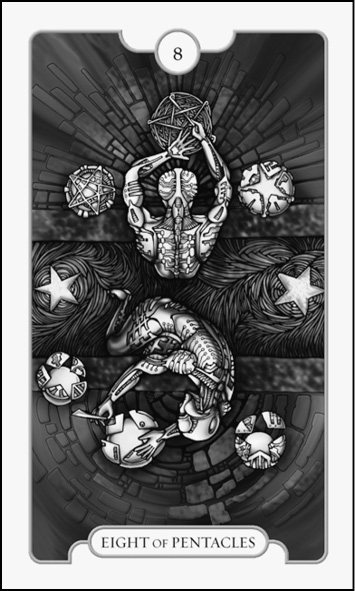

8 of Pentacles
(The Revelations Tarot)
Now, think about which tarot card most closely matches your strengths. Go through the deck and select a card that matches one of your strengths or your experiences. It does not have to be connected to the doubt of the day. Choose a card that represents something real and true about yourself. Here we are more interested in the state of certainty (which is a step toward anti-doubt) than the context.
Tali’s example card was the Eight of Pentacles. Here it denotes that she is certain she has the drive to keep working and creating in order to arrive at the end result. She has a strong work ethic and sense of pride in the work at hand, a determination to get the work completed to the best of her ability. She also has experiences in her life that reflect this strength, so she is happy to choose it as a real card that means something to her.
Now that we have these two cards, one for doubt and one for certainty, we can call upon a divinatory moment to connect them. This is the real magic of creative tarot.
The anti-doubt card is the bridge between doubt and certainty. To find your anti-doubt card, shuffle the rest of the deck whilst thinking about and accepting all of your doubts—even the doubt that you can apply your certainty card to the situation! Be honest with yourself; this is the only place you have that freedom. Then draw a card from the deck.
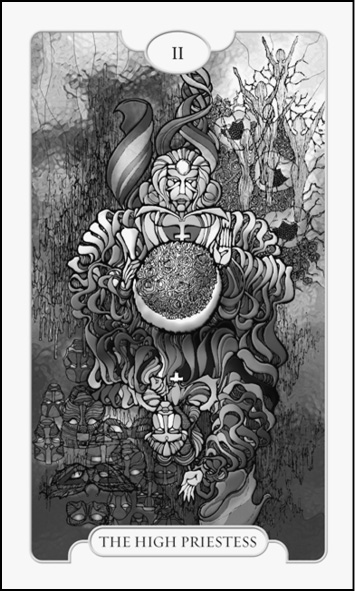

The High Priestess
(The Revelations Tarot)
Place this card between the two cards already selected. It shows you who you must be, or how you must be, to ensure that the doubt is resolved today.
Tali drew the High Priestess, which relates to intuition, the subconscious mind, and that which is hidden. It tells her that she must trust herself and her abilities.
Now for the twist, which compensates for the fact that sometimes we doubt our cards as well as ourselves. Turn the tarot deck upside-down and look at the bottom card. This tells us what to look for today as a sign that our anti-doubt is working.
Tali found the King of Pentacles at the bottom of her deck. This says she should look for all aspects of the King of Pentacles in any way during her day. She should also look for the “loyalty of other people” and “financial ideas and partnership” (see keywords in Around the Tarot in 78 Days). In doing so, she will unconsciously and magically be resolving her doubt and drawing on her strength, without having to do anything other than adjust her attitude. Her attention will be directed by the tarot to what she needs, and the Universe will do the rest.
Exercise: Finding Your Tarot Voice
In chapter 1, we briefly touched on the skill of speaking to and about your cards. Since we have found that many beginning students have trouble accessing their “tarot voice,” we’ve designed this technique to “trick” it out of you. It works by overloading the conscious part of your brain’s language center, so that you can easily access—or more accurately, easily let out—your unconscious voice. This has deep roots in your unconscious processes and hence is more amenable to intuition and rapid connection-making in your readings.
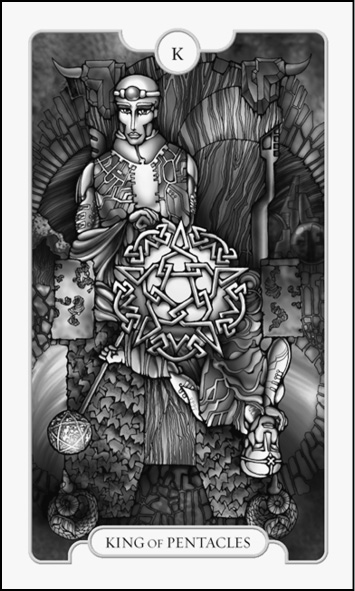

King of Pentacles
(The Revelations Tarot)
Choose a piece of music that has a lot of variation, which you feel comfortable listening to. It should be something that puts you easily into a state of dynamic relaxation, a piece that sounds like a powerful river—strong, yet flowing and in constant movement. Marcus uses Californication by the Red Hot Chili Peppers, but upbeat music from any genre will work equally well. Play the music at a volume that is clearly audible but not overwhelming.
Choose twenty cards at random and lay them out, face-up, in a row so you can see them all. Start to speak out loud, describing what you see on the cards, in either a literal or a symbolic way. As you speak, use linking words and keep the pace as rapid as possible. Here are some common linking words: and, so, when, whilst, because, then, where, or, if.
The aim is not to speak in orderly, complete sentences, but rather to keep the words flowing quickly, without censoring yourself. If you have trouble getting started, turn up the music a bit louder, till it nearly drowns out your voice. This helps to overcome your inner censor.
At some point, you may find yourself overtaken by sentences and words that are not in your conscious control, and appear to arise out of a deeper part of yourself. This is an unmistakable experience when it happens; the first time it does, you may suddenly startle yourself out of it. However, learning to access and trust this deeper intuitive voice is key to giving insightful, intuitive tarot readings. You can (and will) learn to get out of your own way.
Here is an example:
I see a woman holding a bird by a pool and there is a symbol of Venus and I can see lots of flowers and the woman wears a sash so I guess she is very rich because there are lots of coins in the archway there are tulips that probably come from the garden and the coins are now in a box where there are gemstones too which reflect the light because that has a key with some symbols on it and the light is also shining on the forehead of the priestess who is holding a scroll and a pomegranate and the archway is now two pillars as it is night and when the nighttime comes the hawk becomes the owl.
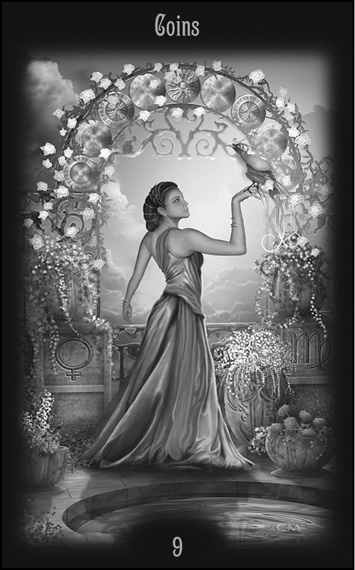
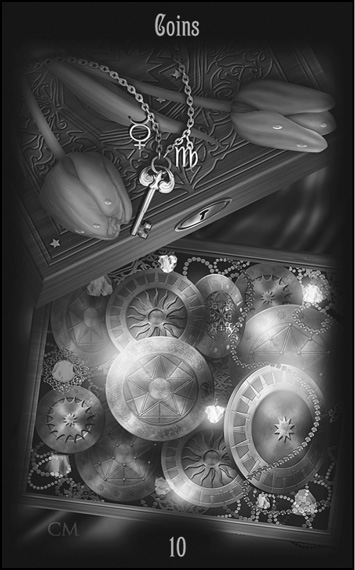
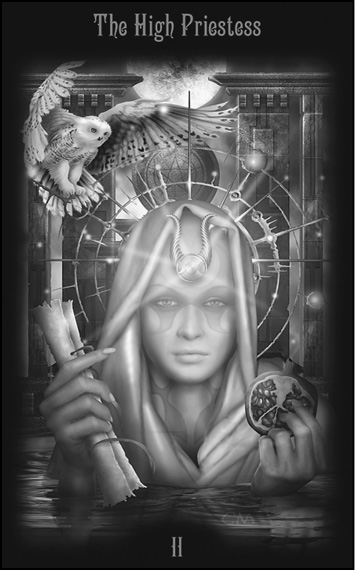
9 of Coins, 10 of Coins, The High Priestess (Legacy of the Divine Tarot)



9 of Coins, 10 of Coins, The High Priestess (Legacy of the Divine Tarot)
All of a sudden, the phrase “when the nighttime comes, the hawk becomes the owl” comes out of our mouth, and we stop and realise that we have just uttered our first oracle, because we have no immediate idea where that came from or what it means. However, our unconscious mind knows, and it brought that phrase to our attention for a reason. Now it’s up to our conscious mind to figure it out.
Based on the cards involved, it could mean that the person for whom we are reading (or even ourselves if this was a reading for ourselves) has reached a “stuck” position with their material existence and must now somehow transform themselves in the darkness of their situation. Instead of being a hunter like the hawk, they must become more wise and patient, like the owl. It may symbolize a shift in their priorities, from the material to the more spiritual. You can ponder other ways of interpreting this oracular phrase.
Once we start to release this inner oracle, we may find our critical mind—our conscious, thinking mind, sometimes called the inner critic—starts to rebel and overanalyse. This is, of course, its job. In face to face tarot, we do not turn away from or attempt to frustrate this tendency; instead, we learn to harness it as a natural feature of our thinking. To do so, we must become aware of how our mind actually works.
We all have an inner, positive, “knowing” voice that guides us. In tarot, this would be represented by the High Priestess card, the deep intuitive part of us that actually lays down the law, which is often depicted as a scroll of Torah (law) on the priestess’s lap. However, this guiding voice is often overpowered by negative thinking, old habits, and even the inwardly projected voices of significant others in our life, particularly our parents—this becomes our inner “criticizing” voice.
This critical voice, which judges us and finds us lacking, is very useful when we are looking to guide ourselves to continual improvement in a tangible skill, such as playing an instrument or a sport. But it is almost entirely useless when we seek to understand and improve a non-tangible skill, such as learning to read tarot cards. It sometimes seems as if the inner critic does not understand that one rule of life is constant change—the Wheel of Fortune card in tarot—and sometimes, astonishing and sudden change, like the Tower. So we had better learn to harness our inner critic and let it pull us, steer us, and guide us, rather than devour us.
Exercise: Harnessing the Inner Critic
For the following exercise, take the Strength card, the Chariot card, and the Judgement card from your deck and lay them out, face-up, in a row. The most common illustrations of the first two cards show the woman and the lion facing each other, and the charioteer facing us—and the world—directly and head-on. In the Judgement card, we face the very highest angel of our own spirit, the last and only true judge of our soul’s progress.
Step 1: Perform a planned reading for someone, or a planned event. For example, you may be giving your first talk on tarot to a new group.
Step 2: When you have completed the experience, write down in your journal a totally positive assessment of how it went, highlighting only the good points—and do it in the third person. That is to say, write it like you are writing about someone else:
Marcus did well to get to the event on time, and most of his material was adequately prepared. He answered one question with good facts that he had learnt ahead of time. He had one person tell him that his diagrams were very useful.
Notice that this doesn’t tell us anything about how “terrible” the rest of the event might have been. The first important thing is to tame the inner critic through the Strength card and enter into a right relationship with it whilst staring down the frightful jaws of the lion. This is completely contrary to what most of us have been taught. We are usually taught at school by a correcting principle—we are told what we have done wrong and are expected to improve as a result. We’re told we have “only” scored a “low” 35 percent on a test, for instance, rather than something more supportive, such as, “You’ve made a good start and know 35 percent of the material so far. Well done.”
Step 3: Now we take on the Chariot and see how we might improve. This is also done in third person, as if we were talking about someone else:
A person who had given a talk like that would benefit most by slowing down in his delivery and pausing to ask questions. He would likely get a better sense of the audience’s comprehension and reduce extensive questions at the end by breaking the presentation into smaller sections.
This is harnessing the inner critic to provide helpful solutions, driving forward like the Chariot, as if we have taken the lion of the previous card and turned it into one of the sphinxes pulling our chariot. Note that there is no specific, personal criticism—we are using the inner voice in a removed sense to allow us space for creativity and positive solutions.
Step 4: Finally, we take a totally removed viewpoint, that of the angel in the Judgement card, looking down on all three positions (yourself, the positive critic, and the helpful critic). Here we summarize the situation:
Having heard that the material was well prepared, and that a talk like that could be made better by slowing it down, I judge that covering less material would be something to try for next time. This would ensure that the one giving this talk would have more space to provide question and answer sessions, breaking up the overall presentation and making it less like a lecture. I would also judge that the presenter should introduce a couple of linking games or exercises to ensure the audience understands the material.
This technique is used a lot in training games, and is a helpful way to get out of the old patterns of negative thinking and useless self-judgment. It works to break the old patterns by forcing a simple change in language, and is a great way of journaling too, particularly to make rapid improvements in your tarot readings. When next you undertake any of the exercises in this book, journal them using these three cards, and learn to harness the inner critic.
Exercise: Getting to the Detail
Another obstacle that beginners and even more experienced readers can face is getting to the detail of a reading, particularly when a querent has asked a very specific question. It can become a difficult situation when the reader is rambling on about the Hermit’s lamp shining brightly across the two wands in the opposing card, when the querent simply wants to know whether to accept a local job offer or travel abroad.7
With this exercise, we will learn how to get a definite answer to any question by focusing on different details from the same three cards: The Initiate, the Two of Wands, and the Three of Pentacles. The practice of this simple technique will install a good “detail machine” in your head. It will also install a powerful unconscious model, which is that the cards are infinitely rich in detail and can be successfully applied to any question that you will ever be asked. Having this experience will automatically give you more confidence in reading—so practice!
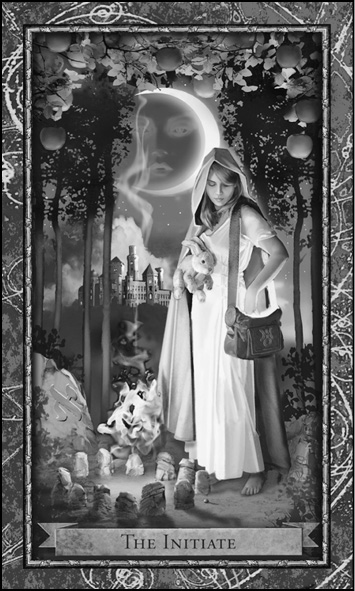
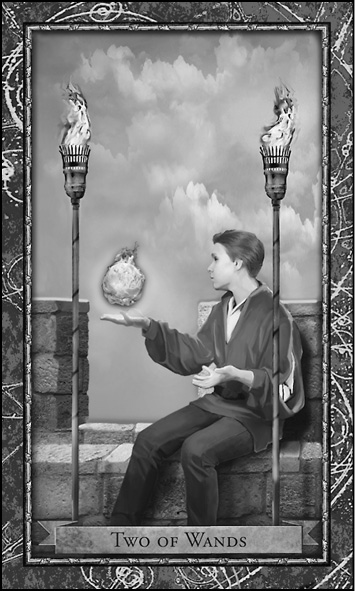
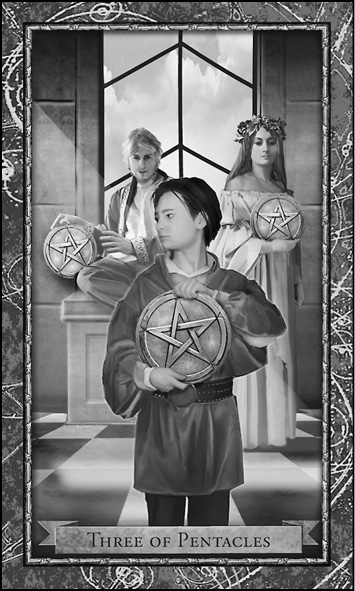
The Initiate, 2 of Wands, 3 of Pentacles (The Wizards Tarot)



The Initiate, 2 of Wands, 3 of Pentacles (The Wizards Tarot)
The question: Whether to pursue an opportunity to go into business with a close friend, or do it by yourself.
The answer: Do it by yourself. Keep the friend as a consultant or stand-by, but do not involve him or her in the business.
The detail: The Initiate is unsure; however, she has a companion to hand, for luck. The character in the Two of Wands keeps the “hot potato” of the new business slightly out of his hand; however, the other hand (the friend) is entirely empty. In the Three of Pentacles, the main character holds tightly to his pentacle, even though others may have their own pentacles to offer.
- What detail would suggest holding back any immediate and significant investment in the business?
The question: A romantic relationship at work appears to be developing; however, the querent is unsure as to whether there will be repercussions later.
The answer: The relationship will be insecure and constantly in the spotlight, so will not amount to a long-term, stable situation. It is mainly the secrecy of the relationship that is the draw, not anything long-lasting.
The detail: The Initiate card shows signs of untested experience—the “fluffy bunny,” the vaporous smoke, the changing moon. The ten apples symbolise “forbidden fruit,” indicating that the drama of the relationship is of more interest than the actual reality. The Two of Wands features two fires; however, they are burning separately, and one of the character’s hands is empty, indicating imbalance or a one-sided relationship. The Three of Pentacles shows the constant observation of two elders who represent bosses at work; the character has to look over his shoulder.
- What detail would show reluctance from the other person in
the relationship?
The question: The querent wants to know where she can find the inspiration and energy to write and finish a novel. However, conversation reveals that she’s never even had articles or short stories published.
The answer: She needs to find a mentor and perhaps an agent who will encourage her, very forcefully, to develop a writing plan with strict deadlines.
The detail: The Initiate card shows the querent looking in her bag, from which a glow represents creativity. However, the same detail as in the prior question shows that her aims and ambitions are wispy. The Two of Wands shows another person holding the creative fire in balance, weighing it up constantly, symbolizing a writing plan and structure. In the Three of Pentacles, we see the apprentice being mentored by two people.
- Getting down to precise detail, what images would indicate whether the agency would be, say, one of these two: “The Monolith Agency” or “The Stars Agency”?
Here are some additional questions for you to answer by using these same three cards. All of them require only simple answers that may come either from one or two details or many aspects of the cards. You may like to share these with other readers and see if you all come up with similar answers.8
1. I am going on a three-month trip. Will I meet someone special?
2. There is a lot of turbulence going on in my career. Will I keep my job?
3. My court case has been extended and my lawyer advises I give in. Should I?
Note that this third question is about a legal issue, and of course a card reading is not a substitute in any way for legal or any other professional advice. However, a reading may provide invaluable insight not otherwise obtainable, and we have many tarot clients who are lawyers, doctors, consultants, and other professionals.
Creating Unique Spreads
and Other Tricks of the Trade
Many of the spreads and methods here were designed spontaneously, in real time, with a querent asking a specific question, which we then turned into a customized spread. This is an extremely useful skill to develop. It’s not as intimidating as it may sound, and once you get the hang of it, you will effortlessly create your own unique spreads for use in a wide range of situations.
Turn a Question into a Spread with Clean Language
In this example, the querent asked a question that was framed as, “I have two options, both of which are possible. One is probably more desirable than the other, but maybe I could do both. They’re both a little bit out of my hands.” Whilst he was asking the question, he was motioning with both hands in circular motions. This was intended to express his own unconscious model of how the two situations were moving and related to each other.
Marcus suggested using the classic “whirlpool” method9 (sometimes called a “ripple spread”), which shows the ramifications of a particular choice or choices, and how these choices are interconnected. He first laidtwo cards down to show the essential nature or source of the two situations. Then he placed a ring of three cards around each of the two source cards to indicate how that particular situation would ripple out. Finally, he placed a ring of six cards around each choice to show the final outcome. At that point, the two rings had expanded on the table to overlap each other, with two cards, one from each situation, touching each other. The querent pointed these out and said, “I suppose this is what happens if I try to do both—they’ll interfere with each other.”
Marcus nodded and said, “Yes, so let’s look at what happens in that case.” At this point, he began to use a simple technique to clarify the actual, underlying issue. This technique is modified from the method of “Clean Language,” based on the work of the late David Grove, a therapist in New Zealand.10 Clean Language can be defined as a technique to clarify a situation through the use of metaphorical language, designed to minimize the impact of a person’s conscious interpretations or assumptions.
In other words, when someone expresses his or her question, it usually has emotional content, which can be turned into a helpful metaphor using a specialized but straightforward series of questions. It only takes a minute or two, and then you have a precise metaphor for the question, against which to design your spread in real time.
The sequence of questions is as follows, with the essential word choices indicated in italics:
Reader: Please restate your question.
Querent: I have two options and I’m concerned that I may not make the right choice. (Note the emotional content of the querent’s phrasing.)
Reader: So you’re concerned. Where is your concern?
Querent: I don’t really know. In my head. (The querent may also gesture unconsciously.) Reader: In your head. Is it outside or inside?
Querent: Inside, in my head.
Reader: Inside your head. I’m wondering how you’d best describe the shape or size of that?
Querent: Well, it’s just everywhere and it’s rushing about.
Reader: Rushing about? And what is that like?
Querent: It’s like a bull in a china shop, really.
So now we have a metaphor, a bull in a china shop. You can then design a spread based on that concept.
You can frame the questions in any particular way, echoing the querent’s own language. The faster you do it, and the more you pay attention to his or her whole communication, including nonverbal gestures, the more noticeable it will be that the question suggests its own spread in response.
The Bull in a China Shop Spread
The querent has asked whether to take an early retirement. He has described how his worries are rushing about like a bull in a china shop. We take the symbols of bull and china shop to quickly lay out a reading:
The Bull cards: What is it that drives the querent? Lay out three cards,
face-up.
The China Shop cards: What will the querent gain or lose from taking early retirement? Lay out three cards, face-up, around the Bull cards.
The Outcome card: What will be the final outcome? Lay out one card, face-up.
You may also use any other variants that may strike you at the time of the reading, or as the querent explains his question, or as the cards are laid down. In this approach, we are using our intuition to be more responsive to the question in our divination, rather than forcing the question into a predetermined spread. It allows us to be more flexible and promotes an active dialogue with the deck, as well as a more engaging experience for the querent.
Turn a Word into a Spread
If you are performing e-mail readings, you can use a keyword in the querent’s question to design an elegant and relevant spread. Here is an example:
Hello, I am asking about my relationship. I have been married for one year and we are discussing having children. I would like to have a reading because my parents used to say I was too irresponsible to have children and I want to know how my future might be if I do.
Here we would take that highly emotional word, irresponsible, as the main concern in the question. We then look up the etymology of the word in a dictionary or online source. We learn that “irresponsible” comes from “not responsible,” and “responsible” comes from similar ideas like “obligation.” The word “obligation” comes from the Latin and means “to bind.” This of course leads to its later use as meaning “to make someone indebted by conferring a benefit or kindness.”
We take the concepts of indebtedness and kindness and turn them into questions for a straightforward linear spread as follows.
1. What debt does the querent owe her parents?
2. What kindness did the querent learn from her parents?
3. What binds the querent in her attitude toward children?
4. What benefit will the querent be able to give to her children?
5. What responsibility will the querent take on?
6. What kindness will her child(ren) bring to her?
You can of course build upon those questions as the cards are placed and you engage in conversation with the spread itself. This can be a very powerful method because it takes much of the expectation for the reading out of your hands and places it, from the querent’s question, directly in dialogue with the cards themselves. Your job is simply to interpret the reading.
Getting a Card to Fit a Question
We have already seen how you can apply any detail on a card to interpret a large range of questions that may be asked. We will see later just how many questions you will face as a tarot reader, and lots more ways of responding to them.
No matter what card is placed in which position of a spread, an experienced reader is able to interpret its meaning starting from basic keywords and concepts. However, this can often be difficult for those new to tarot. For instance, how does one apply a card whose keyword is “trespass” to a question about one’s college exam?
We will use a method called “chunking,” which describes levels of detail applied to thinking. Some people chunk in little details and others like to get the whole picture. Which one are you? If you are a “detail chunker” then you like to read the small print; if you are a “big picture chunker” you don’t need details, you just want to know the overall shape of an idea. Often when an extreme detail chunker and a big picture chunker come face-to-face, it can cause all sorts of communication issues. A model of lateral thinking shows how people chunk in a particular unconscious strategy to solve problems in a creative way. We have applied this model to “making a card fit,” as follows.11
In a question about a relationship, the Three of Wands showed up in the “past” position of a spread. This card has the keyword “building” and the key phrase “activation of ambition” (see the section on keywords in chapter 1). To make this fit, we need to look at the context (or metaphor) in which building makes sense to the question. Thus we can compare building a house to building a relationship. Obviously, setting the foundation comes early on in the process. So we then apply this to a relationship, perhaps seeing that the relationship was “cemented” in the past, based on the person’s high ideals for the union. Those “foundations” are now in the past, denoting that the building has been completed and the relationship has moved on.
In another example, the Six of Wands was laid in the “advice” position of a particular spread. This card has the keyword “weariness.” In the context of a question about entertainment, we would fit it into the reading by saying the querent is advised not to treat the situation as a game, otherwise he or she will tire of it.
Facing Up to Tricky and Slippery Cards
In the early days of a reading career, every reader comes to dread seeing certain cards turn up on his or her table. Of course, these cards then seem to turn up more often. It is almost as if certain cards know they spark some reaction in us.
A typical example is the Hanged Man, a card that Marcus had difficulty with for some years. It was almost as if something was in the card that he just could not get. When it turned up in readings, he would talk about the usual ideas of “suspension,” “hanging around,” and so forth. However, one day he was looking at the card after teaching a therapy class on values. He suddenly saw in the card that the Hanged Man was only fastened to one thing—the tree above. This could be seen as his values—that which supports him.
The Hanged Man can often be found in a situation where one must hold to one’s highest principles and values, even where these seem upside-down and at odds with the world. This is why the Hanged Man appears to be content: he is being entirely true to himself. To him, perhaps the world is upside-down. Further, Marcus realised that every person sees the world through his or her own deep values, and is a projection of those same values. In other words, we see what is most important to us and automatically filter out everything else. Thus we can see that the Hanged Man is a lower version of the Hierophant, someone whose values are absolute and who reveals them fully.
For Marcus, this whole series of thoughts was catalysed by the singular concept that “the Hierophant is revelation, and the Hanged Man is the sacrifice required to receive that revelation. This is initiation.”
Once you have had an experience like this with a slippery or tricky card, you will never forget it. So do keep broadening your reading, and your experience, and returning to the cards regularly. Their mysteries will continually unfold for you.
Exercise: Taking the Card Outside the Box
In this exercise, you will learn a method to confront a slippery card face to face and “trick” it into revealing more about its nature and its interpretation in a reading. These seemingly strange questions are taken from a Surrealist technique, “Exquisite Corpse,” which is one of many such games in the Surrealist movement that can be applied to tarot to take it to whole new areas of thought.
- What might the card’s profession be, other than the one it has?
- Is it happy or unhappy?
- What illness does it call to mind?
- With which historical figure can it be associated?
- How would you kill it?
- What question does it ask?
- What is its favourite song?
- Is it capable of change? How so?
- Does it believe in life after death?
- Is it capable of walking away from
an argument? - Does it come back when you don’t
care about it?
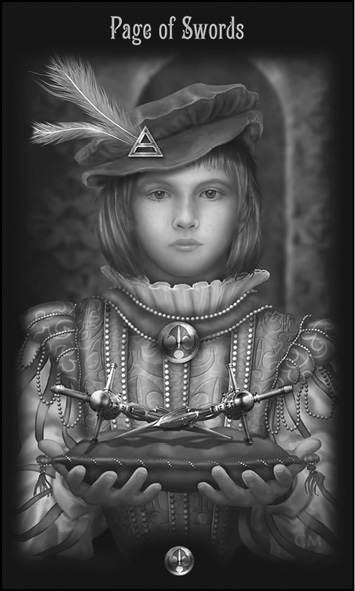

Page of Swords
(Legacy of the
Divine Tarot)
As an example, we might ask the Page of Swords from Ciro Marchetti’s Legacy of the Divine Tarot these questions and receive the following answer:
I am a professional scholar, although I am just starting out. I can be very independent and critical in my work. I am unhappy, as people never understand why I need to be so ruthless to get to the truth of a matter—I just want to gain clarity. I have headaches. I am often seen as the new Kant or even Plato, although I prefer to be associated with the symbolic logic of Charles Dodgson, better known as Lewis Carroll. I can be killed by being ignored or told to shut up, particularly when I ask my favourite question, “What does it mean?” I like the music of Kraftwerk and am always looking to what the Japanese call kaizen, continuous improvement. I do not believe in anything; there are only ever the facts. I only walk away from an argument after I have won it. I don’t really care about you, and I never come back.
There are some surprises in this; we had never really considered how mechanical and predictable the Page of Swords can be, and this is beautifully illustrated in the music of the German electronic band, Kraftwerk. In fact, one might summarise the card as “Vorsprung durch Technik”—advancement through technology.
In this chapter we have seen how we can “install,” or learn, different methods in order to create an entire tarot-reading system. In the following chapter, we will investigate the questions we will be facing in our tarot reading, asked either by ourselves or by others. We will then look at many different ways of responding to these questions in a range of situations.